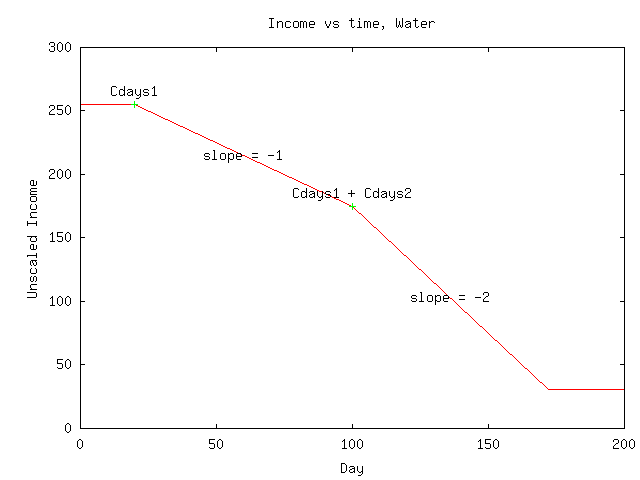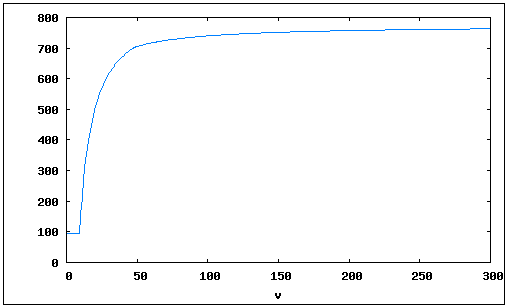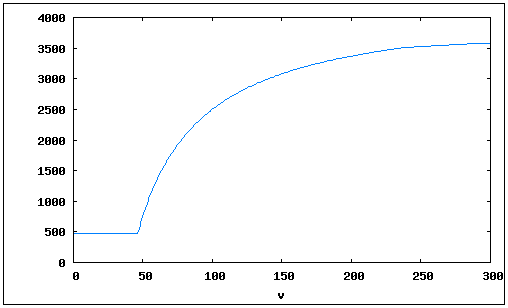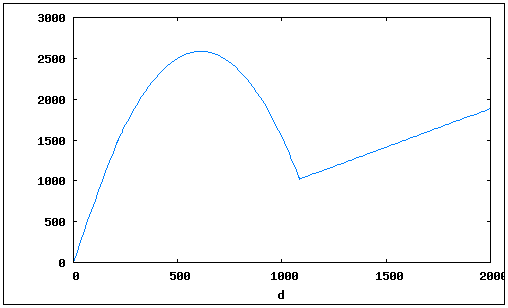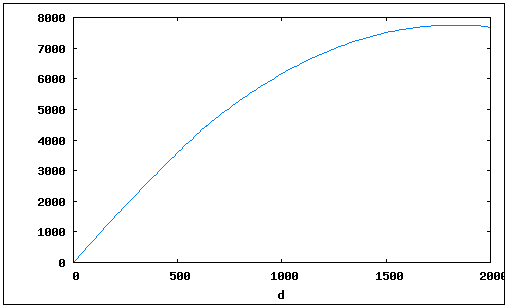- Usa el Manual de Estilo para una correcta edición.
- Recuerda quitar esta plantilla una vez que el artículo haya sido correctamente traducido.
Contents |
Overview
The amount of money earned when delivering a Cargo (en) is determined by four factors: cargo, amount, distance, and days in transit, and is the product of the cargo payment rate, amount of cargo, transit distance, and time factor determined by days in transit.
Before OpenTTD 1.0/r17437, transporting Valuables (en) a distance of fewer than 10 tiles yielded no money.
The transit distance is measured as the distance manhattan distance between the origin station and the destination station.
The time scaler penalizes slow transportation. Each cargo type has two numbers, days1 and days2, that determine the boundaries between "fast", "medium", and "slow".
Note: One "day" on this page is actually 2.5 days in the game. So if days_in_transit = 4, then you use 4 in the calculations that follow, but actually the cargo is already 10 days in transit.
Income(cargo, amount, distance, time) = cargo payment rate ...
This function has the following form:
Magic Numbers
Here, "Base" means the cargo payment rate.
| Cargo Type | Base | Days1 | Days2 |
|---|---|---|---|
| Batteries (en) | 4322 | 2 | 30 |
| Bubbles (en) | 5077 | 20 | 80 |
| Candyfloss (en) | 5005 | 10 | 25 |
| Coal (en) | 5916 | 7 | 255 |
| Cola (en) | 4892 | 5 | 75 |
| Copper Ore (en) | 4892 | 12 | 255 |
| Diamonds (en) | 5802 | 10 | 255 |
| Fizzy Drinks (en) | 6250 | 30 | 50 |
| Food (en) | 5688 | 0 | 30 |
| Fruit (en) | 4209 | 0 | 15 |
| Gold (en) | 5802 | 10 | 40 |
| Goods (en) | 6144 | 5 | 28 |
| Grain (en) | 4778 | 4 | 40 |
| Iron Ore (en) | 5120 | 9 | 255 |
| Livestock (en) | 4322 | 4 | 18 |
| Mail (en) | 4550 | 20 | 90 |
| Maize (en) | 4322 | 4 | 40 |
| Oil (en) | 4437 | 25 | 255 |
| Oil (subtropical) | 4892 | 25 | 255 |
| Paper (en) | 5461 | 7 | 60 |
| Passengers (en) | 3185 | 0 | 24 |
| Plastic (en) | 4664 | 30 | 255 |
| Rubber (en) | 4437 | 2 | 20 |
| Steel (en) | 5688 | 7 | 255 |
| Sugar (en) | 4437 | 20 | 255 |
| Sweets (en) | 6144 | 8 | 40 |
| Toffee (en) | 4778 | 14 | 60 |
| Toys (en) | 5574 | 25 | 255 |
| Valuables (en) | 7509 | 1 | 32 |
| Water (en) | 4664 | 20 | 80 |
| Wheat (en) | 4778 | 4 | 40 |
| Wood (en) | 5005 | 15 | 255 |
| Wood (subtropical) | 7964 | 15 | 255 |
Visualization
Image shows how income depends on 20 passengers delivered 100 tiles away at speed v (in km/h). According to this page equation, income of passengers delivered at 100 km/h equals 96.2% of the income delivered at 600 km/h. This means that the speed of the vehicle sometimes must not be prioritized as much as for example vehicles cargo capacity (especialy dealing with planes).
Also, farther distances are more sensitive to speed. Take a look at the passenger delivery over 500 tiles:
This time, income of 100 km/h is 67.1% against 600 km/h which means that faster vehicle will substantialy increase our income.
Furthermore, very interesting graph we get from distance versus income (same 20 passengers but at 100 km/h):
It is interesting to note that aproximately at 600 tiles you will be getting less and less money, because value of the passengers is falling faster than growing for a longer distance. To add more, if you pay close attention to this page equation, you will notice that if it takes too much time to deliver a cargo, you will be getting constant value of 31 for time. This suggests, that you can get very big income dependant only on the distance if the distance is extremely big (straight line).
Also, if the speed of the vehicle is greater, larger distances can be reached without loss in income. Here is an example of speed of 300 km/h:
Similar graphs can be drawn in-game using new graphs patch.









